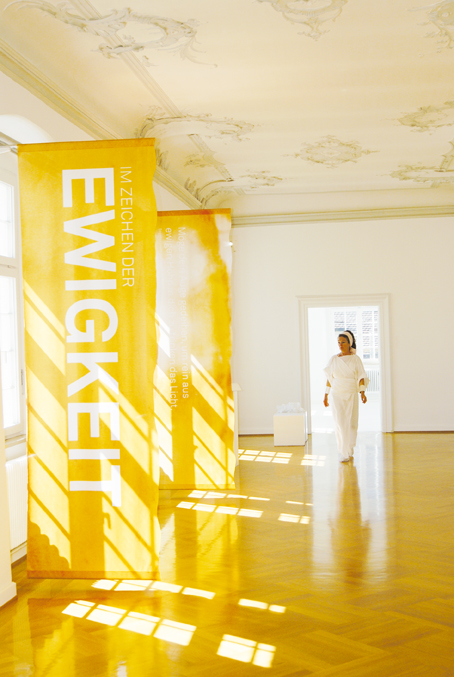 |
|
|
|
|
| IM ZEICHEN DER EWIGKEIT Neues Kloster Bad Schüssenried 2012 Ausstellungskonzept Ps. Planungsstudio Innenarchitektur/Szenografie, Biberach SCHWINGENDE RINGE DES LICHTES Detailaufnahme von DURCHFLUTUNG IV/I ,1984 / 2006/2007 Foto: Athena Grosse-Ruyken |
|
|
|
|
Rita Grosse-Ruyken is an artist of international renown and a member of the German artists’ assocation Deutscher Künstlerbund e.V. Berlin, Forum der Avantgarde deutscher Künstler. Her works of pure gold and silver, sound-modeled to extreme fineness, are of breathtaking grandeur _ capable, as they are, of sublimating the material to release the abundance of light bound by the originally rigid bars of gold and silver. Processed to a state of near transparency, the gold and silver gleam and glow; the gold vessels are endowed with life, light and movement. Freed from service as objects of practical use, Grosse-Ruyken’s art bears the quality of light turned into matter, and transcends to higher spiritual meaning. Rita Grosse-Ruyken presents these works in multi-media form-light-sound-space installations described by Toni Greenbaum of New York as follows: “Within the scope of one installation, Grosse-Ruyken manages to address several prodigious issues at the forefront of art discourse for the past fifty years, particularly the physicality of objects, repetition, light, sound, the sometimes equivocal nature of written text’s ability to communicate meaning, and the spiritual aspect of mathematics.”
Rita Grosse-Ruyken lives and works in an eighth-century mill in Triftern, Lower Bavaria. She herself transformed the mill into a studio serving as the focal point of an island of culture and spiritual research – the “Haselbach Mill Culture Island” – which has been evolving over the past thirty-five years. Over the course of this period, she has produced an impressive artistic oeuvre of international format. Following studies of English and Romance languages at the Ludwig-Maximilians-Universität in Munich and state certification as an art teacher in 1976, she completed her university-level training in gold work and art at the Akademie der Bildenden Künste in Munich in 1978 with an academic degree summa cum laude . Within the framework of the German Academic Exchange Service, she continued her studies of art history and archaeology at the Sorbonne in Paris, then going on to study Sanskrit in India and later – from 1986 onwards – the philosophy of nature.
Since 1983, Rita Grosse-Ruyken has preoccupied herself with artistic investigations serving the further development of transparency in sculptures of refined gold and silver. The Sculpures become instruments for measuring sound and light frequences. Their form and phenomena is movement. Their form conducts and transmits premordial energy and provokes the swing and melody of all phenomena. In this context, she has produced the largest pure gold vessel in the history of our culture. Große-Ruyken`s art carries with the Rays of Light / Durchflutung vessels a powerful concentration of light`s essence. Sound technicans of the Berlin Philharmonic Orchestra carried out tests in 2006 which proofed, that the reverberations of the vessels could be perceived by the human ear. She also carries out research projects on transparency and movement in sculptures of pure gold and pure silver: in part with the aid of a patent by the Niessing company of Vreden, she employs high-tech innovations to make it possible for the pure precious metal to attain a virtually dematerialized, fluid aggregate state in which she can visualize her scientific and philosophical conceptions.
Her works have been exhibited at, among other venues, the Neues Kloster Bad Schussenried (2012), the Deutscher Künstlerbund Berlin (2012, 2009), the Manarat al Saadiyat Cultural District Abu Dhabi, UAE (2011), the Museum Applied Art Frankfurt (2009,2003), the First Gulf Art Fair Dubai, UAE (2007 ), Galerie Thomas (2007,1980, 1978,1975) and the University Gallery Sydney, Australia (2007), the Goethe Institut Inter Nations and the Museum of Arts and Design, New York (2004), the Kunstgewerbemuseum Berlin (1999), ), the Design-Zentrum Nordrhein-Westfalen, Essen (1998), the Neue Sammlung, International Design Museum, Munich (1994,1993,1985), the Münchner Stadtmuseum (1993), the China Art Gallery, Peking and the Schleswig-Holsteinisches Landesmuseum Schloss Gottorf (1986), the National Museum of Modern Art, Tokyo, the Museum of Modern Art Kyoto, Japan (1984),the Museum für Kunst und Gewerbe Hamburg (1983),the Kestner Museum Hannover (1983), the Goethe Institut Hong Kong (1982), the Germanisches Nationalmuseum in Nuremberg and the Kunstgewerbemuseum in Zurich (1981), the Künstlerhaus Wien ( 1980), the Städtische Galerie im Lenbach Haus Munich), and the Kestner Museum Hannover (1979), at the Kunstmarkt Düsseldorf (1978), in seventeen cities in the U.S. and Canada (1977), the Kunstmarkt Köln, Galerie Thomas and Galerie Elektrum London (1975)
The Museum of Modern Art in New York already planned to integrate her works into its collection, departement architecture and design as early as 1984.

